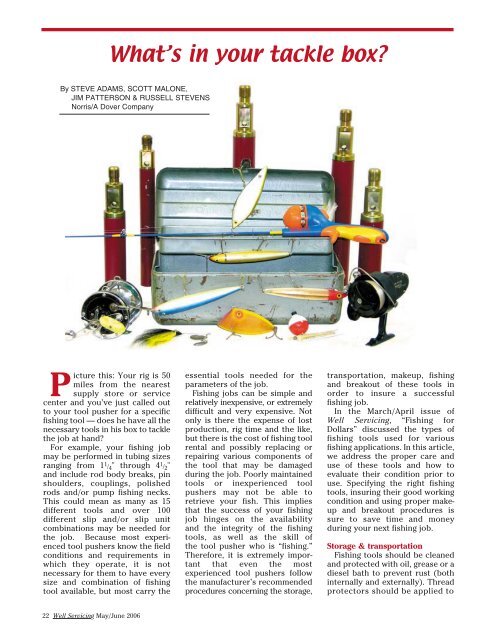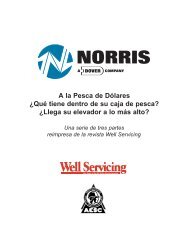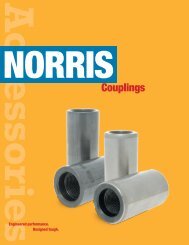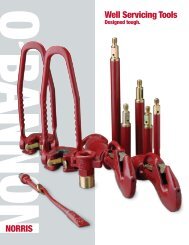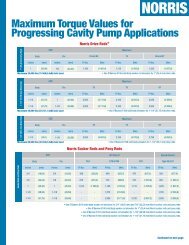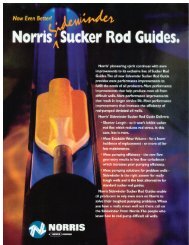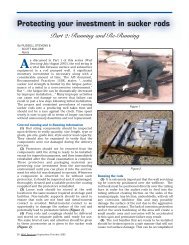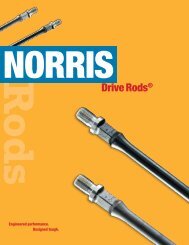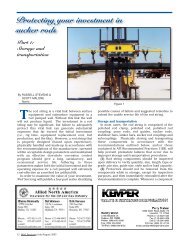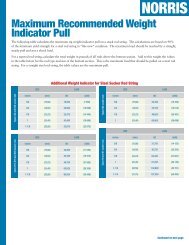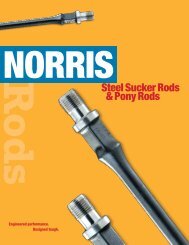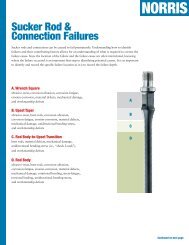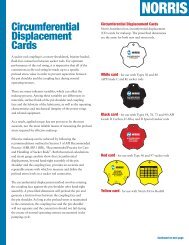What's in your tackle box? - Norris Rods
What's in your tackle box? - Norris Rods
What's in your tackle box? - Norris Rods
You also want an ePaper? Increase the reach of your titles
YUMPU automatically turns print PDFs into web optimized ePapers that Google loves.
Picture this: Your rig is 50<br />
miles from the nearest<br />
supply store or service<br />
center and you’ve just called out<br />
to <strong>your</strong> tool pusher for a specific<br />
fish<strong>in</strong>g tool –– does he have all the<br />
necessary tools <strong>in</strong> his <strong>box</strong> to <strong>tackle</strong><br />
the job at hand?<br />
For example, <strong>your</strong> fish<strong>in</strong>g job<br />
may be performed <strong>in</strong> tub<strong>in</strong>g sizes<br />
rang<strong>in</strong>g from 1 1 / 4" through 4 1 / 2"<br />
and <strong>in</strong>clude rod body breaks, p<strong>in</strong><br />
shoulders, coupl<strong>in</strong>gs, polished<br />
rods and/or pump fish<strong>in</strong>g necks.<br />
This could mean as many as 15<br />
different tools and over 100<br />
different slip and/or slip unit<br />
comb<strong>in</strong>ations may be needed for<br />
the job. Because most experienced<br />
tool pushers know the field<br />
conditions and requirements <strong>in</strong><br />
which they operate, it is not<br />
necessary for them to have every<br />
size and comb<strong>in</strong>ation of fish<strong>in</strong>g<br />
tool available, but most carry the<br />
22 Well Servic<strong>in</strong>g May/June 2006<br />
What’s <strong>in</strong> <strong>your</strong> <strong>tackle</strong> <strong>box</strong>?<br />
By STEVE ADAMS, SCOTT MALONE,<br />
JIM PATTERSON & RUSSELL STEVENS<br />
<strong>Norris</strong>/A Dover Company<br />
essential tools needed for the<br />
parameters of the job.<br />
Fish<strong>in</strong>g jobs can be simple and<br />
relatively <strong>in</strong>expensive, or extremely<br />
difficult and very expensive. Not<br />
only is there the expense of lost<br />
production, rig time and the like,<br />
but there is the cost of fish<strong>in</strong>g tool<br />
rental and possibly replac<strong>in</strong>g or<br />
repair<strong>in</strong>g various components of<br />
the tool that may be damaged<br />
dur<strong>in</strong>g the job. Poorly ma<strong>in</strong>ta<strong>in</strong>ed<br />
tools or <strong>in</strong>experienced tool<br />
pushers may not be able to<br />
retrieve <strong>your</strong> fish. This implies<br />
that the success of <strong>your</strong> fish<strong>in</strong>g<br />
job h<strong>in</strong>ges on the availability<br />
and the <strong>in</strong>tegrity of the fish<strong>in</strong>g<br />
tools, as well as the skill of<br />
the tool pusher who is “fish<strong>in</strong>g.”<br />
Therefore, it is extremely important<br />
that even the most<br />
experienced tool pushers follow<br />
the manufacturer’s recommended<br />
procedures concern<strong>in</strong>g the storage,<br />
transportation, makeup, fish<strong>in</strong>g<br />
and breakout of these tools <strong>in</strong><br />
order to <strong>in</strong>sure a successful<br />
fish<strong>in</strong>g job.<br />
In the March/April issue of<br />
Well Servic<strong>in</strong>g, “Fish<strong>in</strong>g for<br />
Dollars” discussed the types of<br />
fish<strong>in</strong>g tools used for various<br />
fish<strong>in</strong>g applications. In this article,<br />
we address the proper care and<br />
use of these tools and how to<br />
evaluate their condition prior to<br />
use. Specify<strong>in</strong>g the right fish<strong>in</strong>g<br />
tools, <strong>in</strong>sur<strong>in</strong>g their good work<strong>in</strong>g<br />
condition and us<strong>in</strong>g proper makeup<br />
and breakout procedures is<br />
sure to save time and money<br />
dur<strong>in</strong>g <strong>your</strong> next fish<strong>in</strong>g job.<br />
Storage & transportation<br />
Fish<strong>in</strong>g tools should be cleaned<br />
and protected with oil, grease or a<br />
diesel bath to prevent rust (both<br />
<strong>in</strong>ternally and externally). Thread<br />
protectors should be applied to
all p<strong>in</strong> ends to ma<strong>in</strong>ta<strong>in</strong> thread<br />
<strong>in</strong>tegrity. Fish<strong>in</strong>g tools should be<br />
stored <strong>in</strong> a <strong>box</strong> that protects the<br />
tools from physical contact with<br />
one another, or with other metallic<br />
surfaces. (A <strong>box</strong> with <strong>in</strong>dividual<br />
compartments for each fish<strong>in</strong>g tool<br />
or component is recommended.)<br />
Fish<strong>in</strong>g tools and their components<br />
should never be allowed to<br />
“roll” around <strong>in</strong> a tool <strong>box</strong> or <strong>in</strong><br />
the bed of a truck.<br />
Makeup<br />
Prior to use, <strong>in</strong>spect <strong>your</strong> fish<strong>in</strong>g<br />
tools for damage. Figure 1 shows<br />
an example of cracks <strong>in</strong> the<br />
wickered slips. Wickered slips<br />
should be free of cracks and the<br />
wickers should have sharp edges<br />
–– not rounded. Figure 2 shows<br />
the <strong>in</strong>side of an overshot bowl.<br />
Note that from po<strong>in</strong>t A to po<strong>in</strong>t B,<br />
the V-seat is bent <strong>in</strong>ward allow<strong>in</strong>g<br />
the slip unit (Figure 3) to pull<br />
out through the bottom of the<br />
bowl. The V-seat should be<br />
concentric around the entire<br />
circumference on the <strong>in</strong>side<br />
diameter of the bowl <strong>in</strong> order to<br />
properly secure the slip unit when<br />
engag<strong>in</strong>g a fish.<br />
The sucker rod threads and the<br />
shoulder of the top bush<strong>in</strong>g<br />
should be clean and show no<br />
signs of damage. The p<strong>in</strong> shoulder<br />
and the bush<strong>in</strong>g shoulder require<br />
friction to ma<strong>in</strong>ta<strong>in</strong> proper makeup<br />
and should rema<strong>in</strong> clean and<br />
dry (no lubrication). In contrast,<br />
a small amount of thread<br />
lubricant should be applied to the<br />
p<strong>in</strong> threads to help reduce the<br />
<strong>in</strong>terference between threads.<br />
Thread lubricants need to be<br />
smooth, without fillers, have a<br />
grease-like consistency and<br />
conta<strong>in</strong> corrosion <strong>in</strong>hibitors (like<br />
Topco SRL) to facilitate proper<br />
makeup and breakout.<br />
Connections should be free<br />
runn<strong>in</strong>g and made up by hand,<br />
without resistance, to shoulder<br />
contact. Fish<strong>in</strong>g tool connections<br />
do not require extra makeup<br />
torque, from the hand-tight<br />
shouldered contact position, as<br />
long as the threaded connection<br />
“snaps” together at the shouldered<br />
contact position dur<strong>in</strong>g makeup.<br />
The shouldered area should be<br />
clean and dry.<br />
Figure 1 Figure 2<br />
Unlike the sucker rod thread<br />
connection that has 10 threads<br />
per <strong>in</strong>ch (Figure 4), the threads<br />
connect<strong>in</strong>g the top bush<strong>in</strong>g and<br />
bowl of fish<strong>in</strong>g tools have 16<br />
threads per <strong>in</strong>ch (Figure 5). This<br />
helps the fish<strong>in</strong>g tools ma<strong>in</strong>ta<strong>in</strong><br />
proper makeup without becom<strong>in</strong>g<br />
loose dur<strong>in</strong>g the fish<strong>in</strong>g operation.<br />
We Know<br />
Insurance Companies<br />
Member of the Old Republic Insurance Group<br />
Circle Number 094<br />
To facilitate breakout, an adjustable<br />
wrench like a Cresent® wrench<br />
can be placed on the wrench flat<br />
of the top bush<strong>in</strong>g and a friction<br />
wrench can be placed over the<br />
<strong>in</strong>ternal thread area of the bowl.<br />
Pipe wrenches should never be<br />
used <strong>in</strong> makeup or breakout. If a<br />
pipe wrench is placed on a bowl,<br />
Bitum<strong>in</strong>ous has served the energy <strong>in</strong>dustry cont<strong>in</strong>uously for more than<br />
70 years. We offer high-quality <strong>in</strong>surance protection and services—with<br />
stability. That means we don’t jump <strong>in</strong> and out of the energy bus<strong>in</strong>ess when<br />
times get tough.<br />
If you’re look<strong>in</strong>g for broad <strong>in</strong>surance protection for <strong>your</strong> bus<strong>in</strong>ess at<br />
competitive rates, check out Bitum<strong>in</strong>ous. Our people understand <strong>your</strong><br />
bus<strong>in</strong>ess and speak <strong>your</strong> language. We tailor <strong>in</strong>surance packages specifically<br />
for today’s energy companies and we expect to be <strong>in</strong> the market for another<br />
70 years.<br />
Contact <strong>your</strong> local <strong>in</strong>dependent agent for all the facts.<br />
FULL SERVICE BRANCH OFFICES:<br />
Dallas<br />
Indianapolis<br />
Kansas City<br />
Little Rock<br />
Nashville<br />
New Orleans<br />
Oklahoma City<br />
Pittsburgh<br />
St. Louis<br />
San Antonio<br />
Home Office: Rock Island, Ill<strong>in</strong>ois 61201 Phone 1-800-475-4477 www.bitum<strong>in</strong>ous<strong>in</strong>surance.com<br />
Well Servic<strong>in</strong>g May/June 2006 23
other than on the <strong>in</strong>ternal thread<br />
area, damage will occur and<br />
the fish<strong>in</strong>g tool’s <strong>in</strong>tegrity is<br />
destroyed.<br />
Fish<strong>in</strong>g<br />
The tool pusher is as important<br />
to the job as the fish<strong>in</strong>g tool itself.<br />
Experienced tool pushers know<br />
how to fish various types of<br />
breaks by us<strong>in</strong>g techniques they<br />
have learned from other experienced<br />
tool pushers. Once the fish<br />
is engaged by the fish<strong>in</strong>g tool, a<br />
slow, steady pull is required to<br />
retrieve the broken part. The<br />
fish<strong>in</strong>g tool should never be<br />
“jarred” when try<strong>in</strong>g to unseat the<br />
pump. If a slow, steady pull fails to<br />
unseat the pump, an experienced<br />
tool pusher knows he must pull a<br />
predeterm<strong>in</strong>ed amount of tension<br />
<strong>in</strong> the rod str<strong>in</strong>g and set the brake<br />
for approximately 10 to 15 m<strong>in</strong>utes<br />
before try<strong>in</strong>g aga<strong>in</strong> to unseat the<br />
pump. After repeat<strong>in</strong>g this process<br />
several times, if the pump fails<br />
to unseat, the experienced tool<br />
pusher now realizes he has a<br />
“stripp<strong>in</strong>g” job on his hands.<br />
LLOYD SAVOY<br />
SALES MANAGER<br />
KING OIL TOOLS<br />
PHONE: (800) 910-5464<br />
FAX: (580) 233-6807<br />
MOBILE: (337) 230-8226<br />
GEFCO<br />
2215 S. VAN BUREN<br />
P.O. BOX 872<br />
ENID, OK 73702<br />
Websites<br />
www.gefco.com<br />
www.k<strong>in</strong>goiltools.com<br />
Figure 3 Figure 4<br />
Figure 5<br />
24 Well Servic<strong>in</strong>g May/June 2006<br />
Breakout<br />
Once the “fish” is landed, the<br />
top bush<strong>in</strong>g must be disengaged<br />
from the bowl <strong>in</strong> order to facilitate<br />
the removal of the fish back<br />
through the top of the fish<strong>in</strong>g tool.<br />
In order to disengage the wickered<br />
Figure 6<br />
slip or slip unit from the fish, the<br />
fish<strong>in</strong>g tool should be placed up<br />
off the ground on a block of wood<br />
(Figure 6). At this po<strong>in</strong>t, either<br />
strike the fish, or place another<br />
block of wood on top of the bowl<br />
and strike the wood <strong>in</strong> order to<br />
drive the fish out through the top<br />
of the fish<strong>in</strong>g tool (Figure 7). Do<br />
not directly strike the fish<strong>in</strong>g tool<br />
with the hammer or allow any<br />
Figure 7<br />
contact with any hard material<br />
substance that might cause<br />
damage to the fish<strong>in</strong>g tool.<br />
By follow<strong>in</strong>g these simple guidel<strong>in</strong>es,<br />
you will have a greater<br />
chance of successfully “fish<strong>in</strong>g”<br />
<strong>your</strong> well. So know what’s <strong>in</strong> <strong>your</strong><br />
“<strong>tackle</strong> <strong>box</strong>” before you go out to<br />
the well and you will be sure to<br />
catch <strong>your</strong> “fish.”


